Home
Repair And Restoration
Norton Electra Starter
Details reveived 21 August 2025
By Ian Soady
The Norton Electra starter system is quite simple in essence. This shows the general layout of the system:
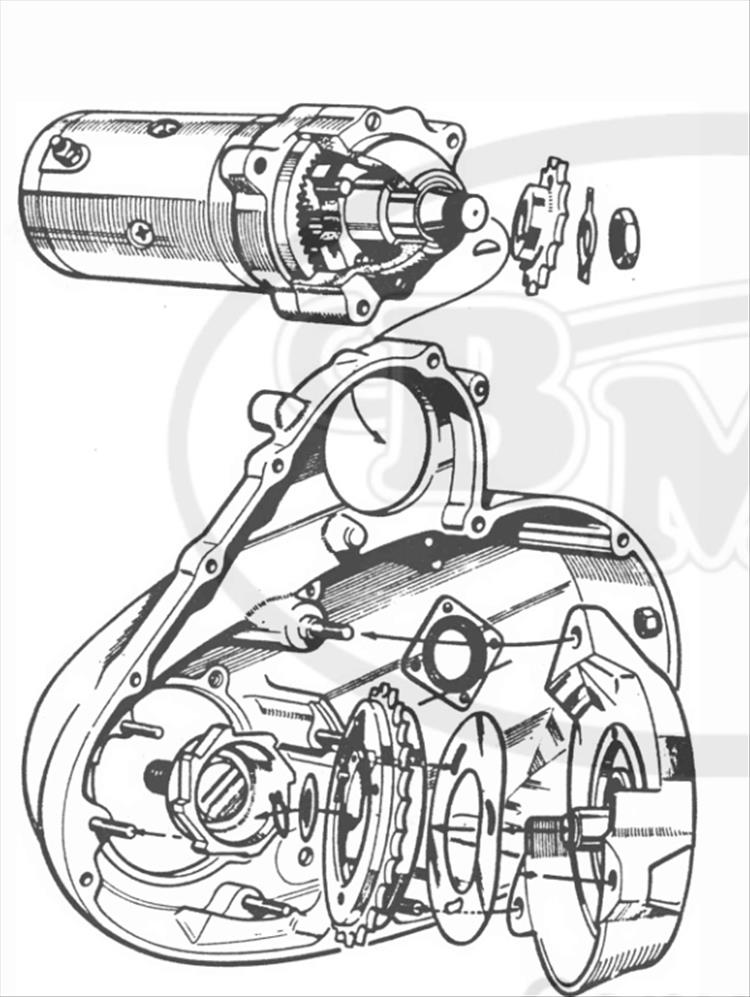
And this is a detailed technical drawing:
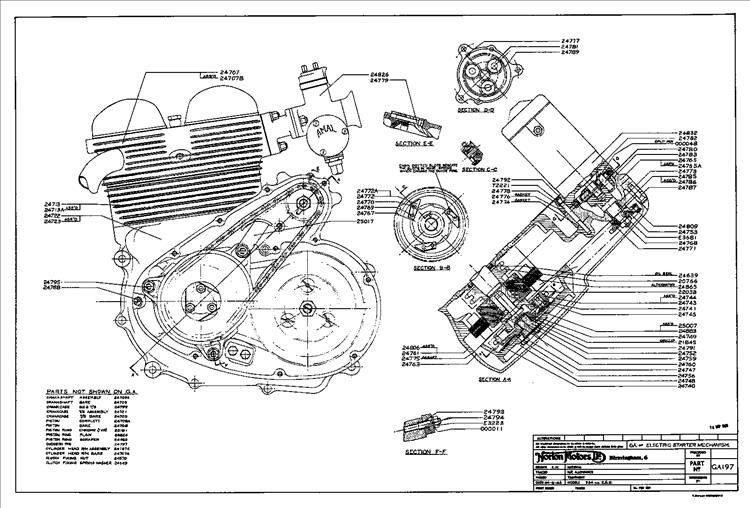
It consists of a starter motor which drives a small sprocket inside the primary drive casing via an epicyclic gear for speed reduction and torque increase. This sprocket drives a larger sprocket assembly which is mounted in an alloy casting outboard of the engine crankshaft end. These are the parts laid out:
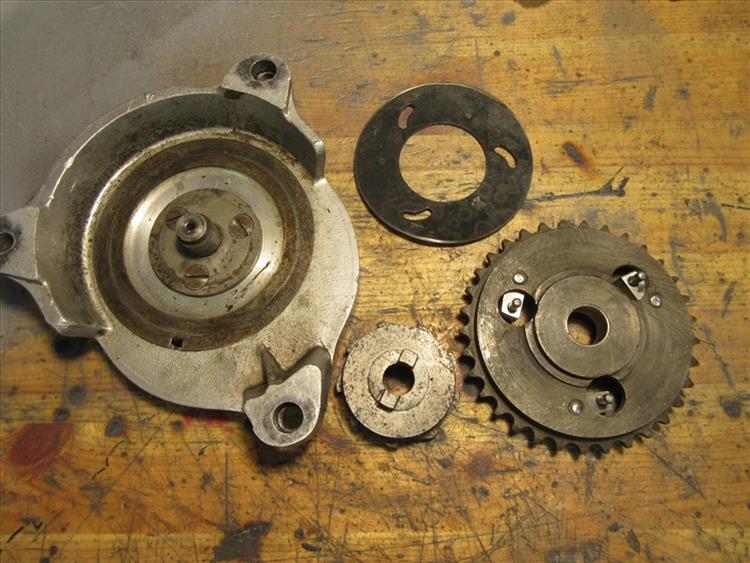
This is the bare sprocket assembly ie without pawls.
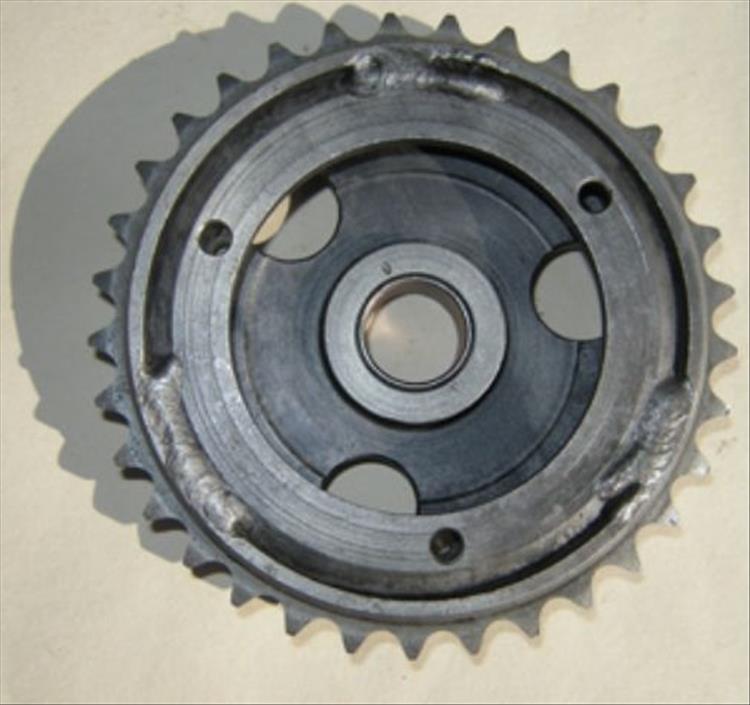
The sprocket is free to rotate on a fixed spindle and bears against a wavy annular spring steel washer squeezed between the sprocket assembly and the mounting. This shows an old washer and a new one. This washer then bears against a thin steel plate which is keyed to the mounting casting. The wavy spring effectively acts as a clutch which will slip when a certain level of torque is applied to it. Interestingly, the original washer was a single layer; the later spares are 3 layers spot welded together. Perhaps the single washer didn't exert enough axial force of perhaps it's to give a bigger bearing surface on the actuating pins.
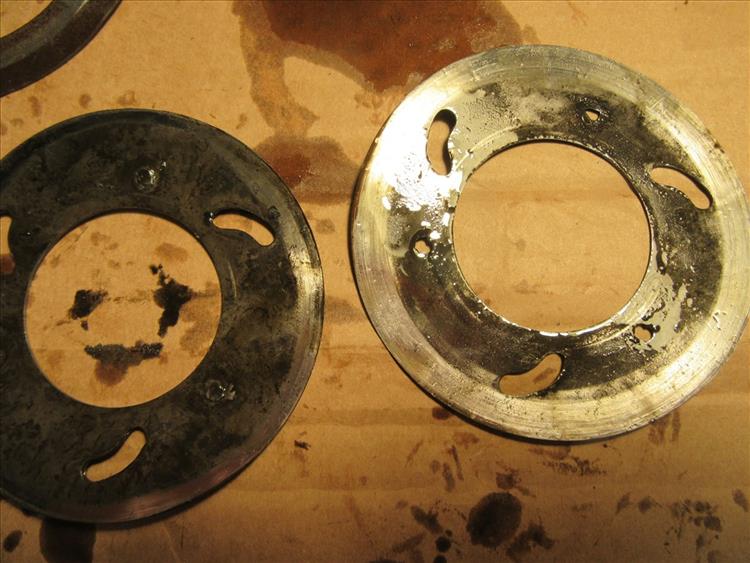
The sprocket assembly has a set of 3 pawls (dogs) which pivot at their outer ends in the sprocket assembly. Their inner ends have steel 4mm diameter pins ‐ not described separately in the parts diagrams but I will call them actuating pins ‐ which engage in the arced slots visible in the wavy washer.
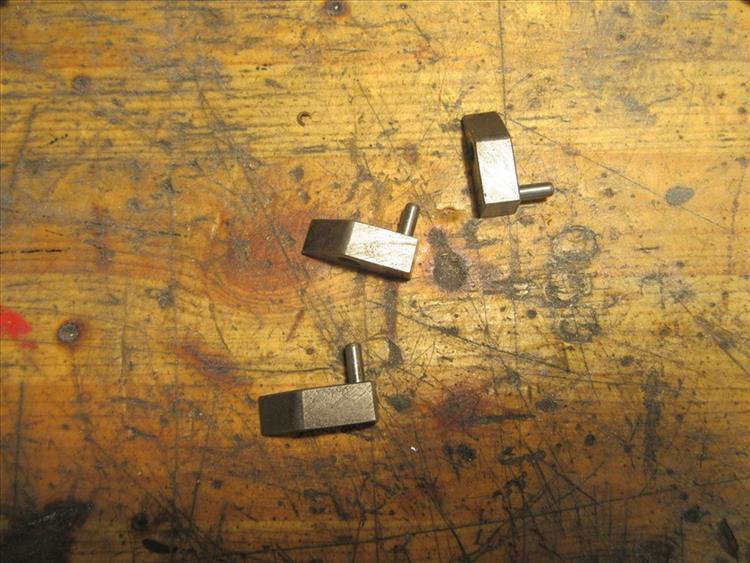
At rest, the actuating pins are in the outer ends of the slots. When the starter is actuated, the wavy washer is dragged round by the sprocket assembly against the friction between it and the previously mentioned steel plate. This pulls the pins down the arced slots, forcing the pawls to rotate slightly, and bringing their business ends towards the crankshaft centre line. On the crankshaft is mounted a ratchet.
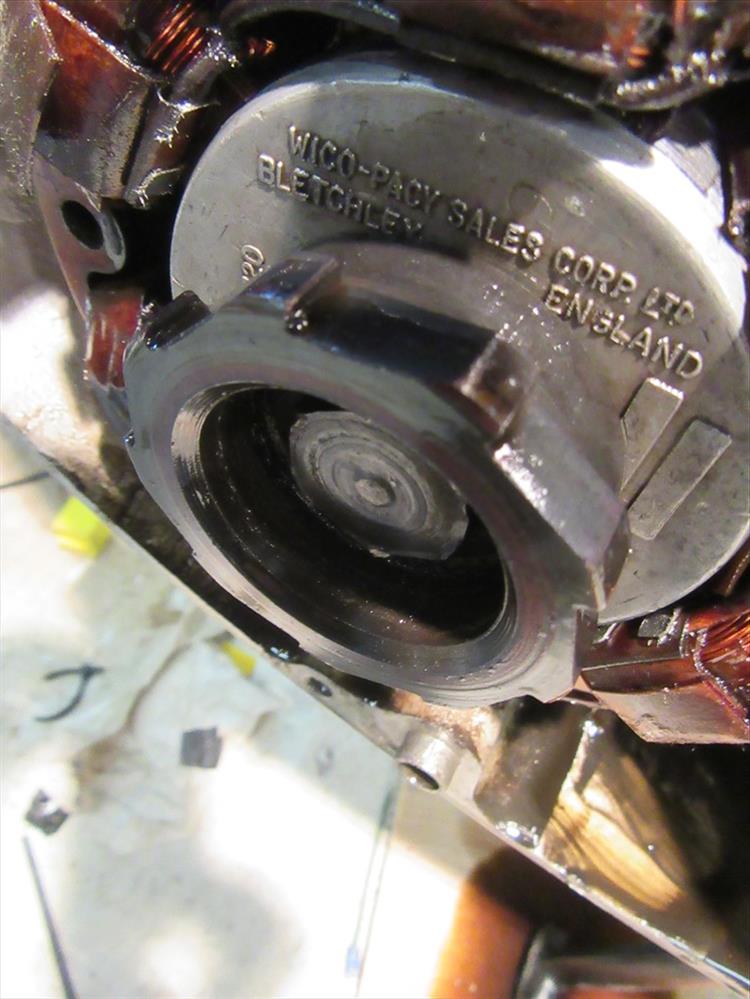
This is actually a fairly worn original item. Rotation of the sprocket assembly causes the 3 pawls to engage with the undercut faces of the ratchet on the crankshaft thus forcing it – and hence the engine ‐ to rotate. At this point there should be little force on the actuating pins as the pawls are resting against their pivots and the load is taken by these and the ratchet / pawl faces. This shows the assembly in "starting" position.

Once the engine starts, the ratchet rotates more rapidly than the sprocket assembly causing the wavy washer to slip and pushes the pawls out ( and hence moves the actuating pins outwards along the slots) so they are no longer in contact with the ratchet, as below.

There are a number of weak points in this arrangement. One is that it depends on a reliably consistent amount of slip between the wavy washer and the backplate. It has been reported that some bikes will start readily when cold but struggle when hot, possibly because of this.
Perhaps the most important is that there is no backfire protection, apart from the fact that the wavy washer can act as a clutch so allowing a certain amount of slip. I suspect this was a contributory cause of breaking / bending the actuating pins. Another is that once wear sets in, particularly in the pawls, ratchet and wavy washer, load may be concentrated on two or even one of the pawls. This can cause unwanted sideways force on the 4mm pins resulting in bending and/or breaking.
I found that all parts of mine were worn although not, I thought, catastrophically. The main problem was that one actuating pin had broken and its corresponding pawl was quite badly damaged where it meets the ratchet. I assume it had been bouncing over the ratchet face. The other two were also slightly worn on the mating faces. Fortunately the Norton Owners Club have stocks of wavy washers, sprocket assemblies and crankshaft ratchets (all New Old Stock) at very reasonable prices. Not so the pawls which are unobtainable. So through a model engineering forum I found a retired gunsmith in Lancaster who reckoned he could build up my damaged items with hard alloy in return for a donation to his local hospice.
Although I was initially a little doubtful I parcelled up the pawls and sent them off. I was so pleased to unwrap a package a couple of weeks later with the pawls looking as good as new.
I also asked that model engineering forum about the pivot pins and 4mm pins. I'd tried silver steel and (following advice from the NOC forum) 4mm drill bit shanks. Both bent almost immediately. Possibly due to, but certainly not helped by, the badly worn pawl. The model engineering forum consensus was to use hardened and ground dowel pins, These are readily ‐ and cheaply ‐ available via ebay in correct diameters although needed shortening slightly. So I used these on the rebuild.
Having all my shiny bits to hand it was time to screw it all together and cross my fingers. A few initial attempts with the starter ‐ but ignition off ‐ showed that the engine spun over very readily. Turning the ignition on resulted in a couple of coughs then the engine burst (well limped) into life.
All the above was written before the latest episode in the saga which is documented in the Repair Chat area of B&T.
Share your repairs and tips - click here.
Ren - The Ed here - the detailed drawing is reduced in size for this website. Here is a link to Ian's own image hosted on his own site. It's larger so the details are clearer - Norton Electra Starter Details Diagram
Reader's Comments
Upt'North ¹ said :-
I learnt about Wipac today.
Ta fella.
The drill bit advice surprised me, in my experience drill bits can be very brittle.
Looks like a great finished job. Plus the Hospice benefits too.
Upt.
27/08/2025 09:50:54 UTC
Ian Soady¹ said :-
Yes, I think drill bits vary - some are soft at the end that's held in the chuck, others hard hence can be brittle. I'm happy with the job so far. Last week I went out to the garage every morning and started the engine - each time it burst into life immediately although I didn't run it for long.
So on Monday I decided to give it a try and rolled out onto the road. Again it started instantly and was performing very nicely - although with an occasional slight miss on acceleration - till I got about 10 miles away when it died at a junction and refused to restart. My days of grovelling around in the gutter being well past I called the breakdown service and settled down to wait.
What a nice bunch of people live in Little Alne! About 5 minutes after I stopped a lovely lady from a house opposite came across and offered me tea, water and a place to sit. A few minutes later a bloke walked up and offered me the use of hs spanners. Two passing motorcyclists slowed down to check I was OK. Another bloke came across for a chat and to see if he could help - he was restoring a TK Bedford. And yet another arrived just as the breakdown van hove into view. He had a new Enfield and was enjoying it.
Fortuitously there was a pub just across the way so I could enjoy a fortifying half of IPA (although I was short changed as I discovered later). And the breakdown service - Britannia - arrived after about an hour of my calling them. The chap was very careful and efficient.
When I had the bike in the garage I checked it over. Still not starting, although a healthy looking spark, and of course the battery's getting low so that's now on charge. Removing the plugs showed that they were very pale indicating a weak mixture so I've raised the jet needle a notch as that's where most of the running is done. Many people fiddle with main jets but as I rarely use full throttle - and I suspect few others do - as long as it's big enough it can wait till I have the other variables sorted out. I do wonder if the petrol tank breather is not passing enough air but the flow seems reasonable.
And of course the cheap petrol tap I fitted is now leaking so that needs replacing. Never a dull day in sunny Redditch.
27/08/2025 10:21:01 UTC
Ian Soady¹ said :-
By the way, Wipac (Wico-Pacy) were second only to Lucas and closely followed by Amal in the vitriol applied to their products. The real culprits were the British bike industry who insisted on the cheapest possible components. In the 1950s Lucas Wader magnetos were world renowned. Not so their alternator - and worse their "energy transfer" electrical systems which were a factor in many people moving over to Japanese machinery.
27/08/2025 14:22:22 UTC
Upt'North ¹ said :-
The great Lucas motto...
Get home before dark!
27/08/2025 18:55:40 UTC
Ren - The Ed¹ said :-
Eeeee by 'eck, it's like stepping back in time listening to you 2!
28/08/2025 07:51:39 UTC
Ian Soady¹ said :-
Waiting for the man....
I thought you may like to see a pic of the Electra resting at the roadside.
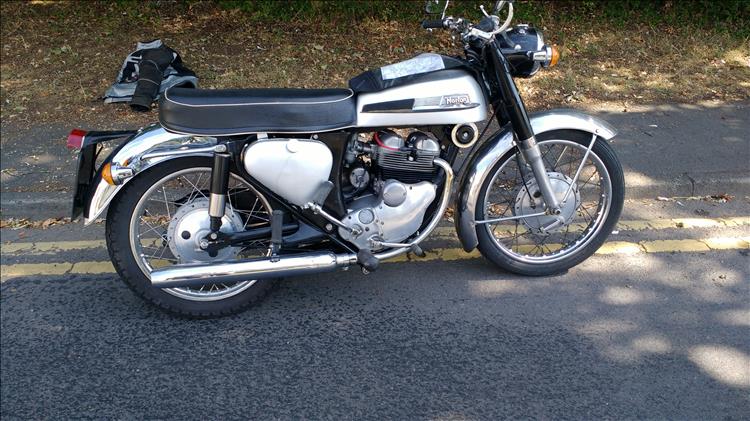 28/08/2025 09:57:58 UTC
28/08/2025 09:57:58 UTC
nab301 said :-
I remember as a youngster dismantling the malfunctioning Sturmey Archer 3 speed Epicyclic gearbox on my bicycle....
as for Lucas the prince of darkness Ian is correct I remember an old timer who worked in the industry telling me that the Bike Industry named the price and Lucas manufactured it to that (low ) standard .
Ian is that sprocket as it was OE , welded to the centre (hub") ?
Nigel
28/08/2025 16:01:22 UTC
Ian Soady¹ said :-
Yes indeed it's genuine Plumstead welding. Better than mine I have to say although it wouldn't have passed muster at Bracebridge Street. It is a bit of an odd design.
28/08/2025 17:38:08 UTC
Name
Comment
Add a RELEVANT link (not required)
Upload an image (not required) -
Uploading...
Home
Repair And Restoration